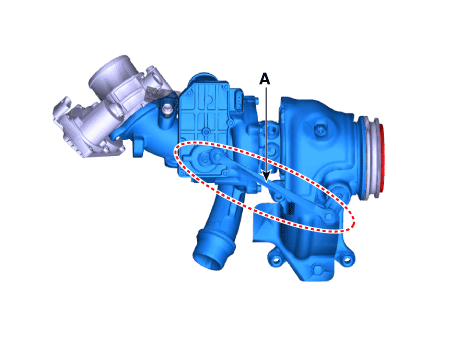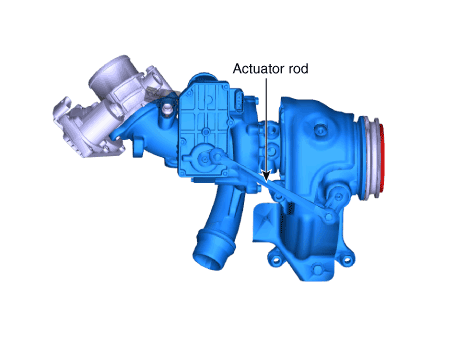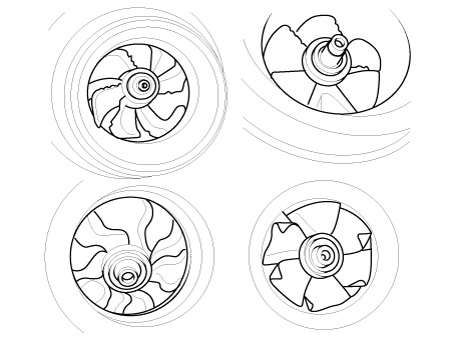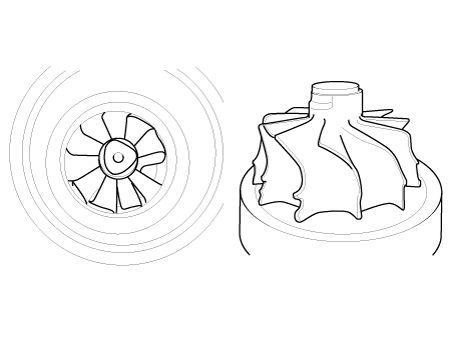Hyundai i-30: Intake and Exhaust System / Turbo Charger
Components and components location
| Comoinents |
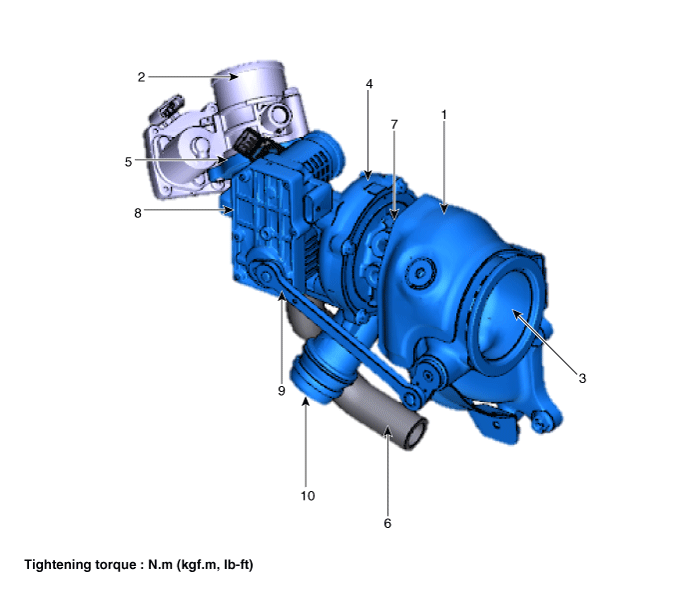
| 1. Heat protector 2. DPV assy 3. Turbine housing 4. Compressor housing 5. Compressor inlet |
6. EGR outlet
hose 7. Center housing 8. Electric waste gate actuator (EWGA) 9. Actuator rod 10. Compressor inlet |
Repair procedures
| Removal and Installation |
| 1. |
Remove the turbo manifold module.
(Refer to Intake and Exhaust System - "Turbo Charger & Exhaust Manifold")
|
| On-vehicle Inspection |
| Turbocharger Diagnostic Flow |
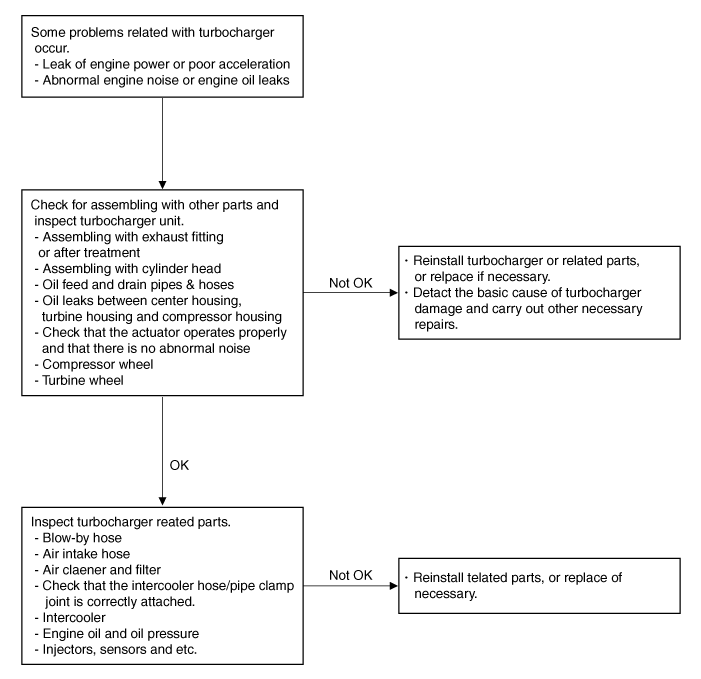
If any problem related with turbocharger, such as lack of engine power, poor
acceleration, abnormal engine noise or oil leaks, may occur, check the turbocharger
according to the procedure as follows.
| 1. |
Check for assembling of the turbocharger and the exhaust fitting (or
the after treatment).
If a gas leak occur as a gasket was not installed or mounting bolts
(or nuts) were tightened inadequately, it may cause abnormal engine
noise.
If the cause of the problem is detected, retighten the mounting bolts
(or nuts) as the specified torque or replace the gasket or damaged parts
with new ones if necessary.
|
| 2. |
Check for assembling of the turbocharger and the cylinder head.
If a gas leak occur as a gasket was not installed or mounting bolts
(or nuts) were tightened inadequately, it may cause abnormal engine
noise.
If the cause of the problem is detected, retighten the mounting bolts
(or nuts) as the specified torque or install a new gasket if necessary.
|
| 3. |
Check the turbocharger oil feed pipe & hose and oil drain pipe & hose.
If a gas leak occur as a gasket was not installed or mounting bolts
were tightened inadequately, it may cause oil leaks.
If the oil feed pipe & hose is damaged, engine oil is not supplied sufficiently
to the turbocharger then it may damage the turbocharger. If the oil
drain pipe & hose is damaged and clogged, engine oil is not drained
smoothly then it may cause oil leaks from the turbocharger.
If the cause of the problem is detected, retighten the mounting bolts
(or nuts) as the specified torque or replace the gasket or damaged parts
with new ones if necessary.
|
| 4. |
Check for oil leaks between turbine housing and compressor housing.
If the O-ring (gasket) between the center housing and the compressor
housing is damaged, it may cause oil leaks.
If an oil leak is detected, replace the turbocharger with a new one.
|
| 5. |
Inspect the rod unit of the electric waste gate actuator (EWGA).
If the marking does not match, there have been modifications at some
point since manufacture.
This can affect engine performance.
If any issue is found, replace the turbocharger.
|
| 6. |
Check the electric waste gate actuator (EWGA)
If the turbocharger actuator is damaged, it may cause lack of engine
power and poor acceleration.
If the actuator rod does not move, replace the turbocharger with a new
one.
|
| 7. |
Check the turbocharger compressor wheel.
If the compressor wheel are damaged, it may cause abnormal noise from
the turbocharger and poor acceleration.
If the compressor wheel are damaged or deformed, replace the turbocharger
with new ones.
|
| 8. |
Check the turbocharger turbine wheel.
If the turbine wheel are damaged, it may cause abnormal noise from the
turbocharger and poor acceleration.
If the turbine wheel are damaged or deformed, replace the turbocharger
with new ones.
|
If any problem is not detected in the turbocharger, check the turbocharger-related
parts according to the procedure as follows.
| 9. |
Check the blow-by hose.
If the breather hose is bent or clogged, the internal pressure in the
engine increases then engine oil is not supplied smoothly to the turbocharger.
So it may cause damage of the turbocharger and oil leaks.
If the cause of the problem is detected, replace the breather hose or
the related parts with new ones.
|
| 10. |
Check the air intake hose connected to the turbocharger.
If a cross-section of the hose diminishes as the air intake hose is
bent or crushed, intake air to the turbocharger reduces and the pressure
in front of turbocharger drops. So it may cause damage of the turbocharger
and oil leaks. If the air intake hose is detached or torn, a foreign
substance goes into the turbocharger and causes damage of it.
If the air intake hose is damaged, replace it with a new one.
|
| 11. |
Check the air cleaner.
If the air cleaner filter is moistened or polluted excessively or a
non-genuine part is used, intake air to the turbocharger reduces and
the pressure in front of turbocharger drops. So it may cause damage
of the turbocharger and oil leaks. .
If the air cleaner filter is moistened or polluted excessively, replace
it with a new one.
|
| 12. |
Check the intercooler hoses & pipes.
If the intercooler hoses & pipes are damaged or disconnected, oil leaks
may occur from the hoses & pipes and the turbocharger may exceed the
permissible speed then it may cause damage of the turbocharger.
If the intercooler hoses & pipes are damaged, replace them with new
ones.
|
| 13. |
Check the intercooler.
If the intercooler is damaged, the turbocharger may exceed the permissible
speed then it may cause damage of the turbocharger.
If the intercooler is damaged, replace them with a new one.
|
| 14. |
Check the engine oil.
If the engine oil level is low, amount of engine oil fed to turbocharger
reduces then the bearings in the turbocharger may adhere due to insufficient
lubrication and cooling.
If the cause of the problem is detected, add or change engine oil.
|
| 15. |
Check the engine oil pressure.
If the engine oil level is low, amount of engine oil fed to turbocharger
reduces then the bearings in the turbocharger may adhere due to insufficient
lubrication and cooling.
If the cause of the problem is detected, add or change engine oil. If
foreign substances are accumulated on the oil screen, wash the oil screen
and replace the injector’s washer with a new one after checking the
injectors for gas leaks. Check the engine oil-related parts, such as
oil pump, if necessary.
|
| 16. |
Check the injectors, sensors, etc.
(Refer to Engine Control / Fuel System)
If the injectors, sensors and etc. don’t work properly, it may cause
lack of engine power.
If the cause of the problem is detected, replace the related parts with
new ones.
|
 Intake Manifold
Intake Manifold
Components and components location
Components
1. Intake manifold
2. Throttle body gasket
3. Throttle body
4. Vacuum pipe & hose assy
5...
 Turbo Charger & Exhaust Manifold
Turbo Charger & Exhaust Manifold
Components and components location
Components
1. Catalytic
converter (WCC)
2. Turbo manifold module
3. Catalytic converter (WCC) heat protector
4...
Other information:
Hyundai i30 (PD) 2018-2025 Owner's Manual: AUTO STOP Indicator Light. Immobiliser Indicator Light
AUTO STOP Indicator Light This indicator light illuminates: • When the engine enters the Idle Stop mode of the ISG (Idle Stop and Go) system. This indicator light blinks: • When the automatic starting occurs, the AUTO STOP indicator on the cluster will blink for 5 seconds...
Hyundai i30 (PD) 2018-2025 Service Manual: Tire Pressure Monitoring System
Description and operation Description Indirect Tire Pressure Monitoring System (TPMS) Using a wheel speed signal from the ESC, the system analyzes the turning radius of the tire and change in tire stiffness to detect a pressure loss...
Categories
- Manuals Home
- 3rd Generation i30 Owners Manual
- 3rd Generation i30 Service Manual
- Tyre pressure monitoring system
- Battery replacement
- Shift-lock system. Shift-lock release
- New on site
- Most important about car
Door locks
Operating door locks from outside the vehicle
Mechanical key
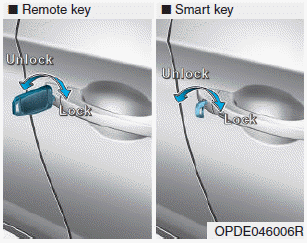
Turn the key toward the rear of the vehicle to unlock and toward the front of the vehicle to lock.
If you lock/unlock the driver's door with a key, a driver’s door will lock/unlock automatically.
Copyright © 2025 www.hi30.net

